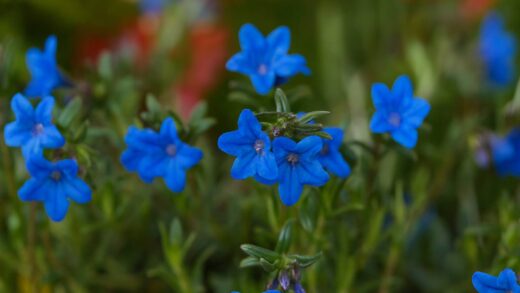Anemone hepatica is a modest feeder, adapted to the nutrient-cycling environment of a woodland floor where a slow and steady supply of nutrients is released from decomposing organic matter. It does not require or appreciate heavy applications of synthetic chemical fertilizers. The primary goal in feeding liverworts is to create and maintain a humus-rich, biologically active soil that provides all the necessary nutrients in a natural, slow-release form. The most effective way to achieve this is through the consistent incorporation of well-decomposed organic matter, such as leaf mold, garden compost, or well-rotted manure. This approach not only feeds the plant but also improves soil structure, aeration, and moisture retention, creating a holistic and sustainable growing environment.
The foundation of a good nutrition program is laid before the plant even goes into the ground. Thoroughly preparing the planting bed with generous amounts of organic matter ensures that the plant has access to a reservoir of nutrients from the very beginning. This initial soil amendment is often sufficient to support the plant for its first couple of years, as it focuses on establishing a strong root system. Rushing to fertilize a newly planted liverwort is unnecessary and can be counterproductive, potentially burning the delicate, developing roots.
For established plants, an annual top-dressing with organic matter is the best method of fertilization. This is typically done in the autumn, after the leaves have died back, or in very early spring before new growth emerges. A layer of about 2-3 centimeters of sieved leaf mold or fine compost can be carefully spread around the base of the plant, mimicking the natural leaf fall that would occur in its native forest habitat. Over the winter and spring, earthworms and other soil organisms will work this organic matter into the soil, slowly releasing its nutrients to the plant’s roots.
This method of slow-release feeding is perfectly synchronized with the plant’s natural growth cycle. The nutrients become available in the spring, just as the plant requires energy for flowering and producing new leaves. This gentle approach avoids the sudden flushes of growth that can be stimulated by high-nitrogen chemical fertilizers, which can result in soft, weak foliage that is more susceptible to pests and diseases. The focus is on building soil health, which in turn supports plant health.
Understanding nutrient needs
While a balanced supply of nutrients is important, Anemone hepatica has a particular appreciation for calcium and magnesium, reflecting its common occurrence in limestone-rich woodland soils. The soil pH should ideally be neutral to slightly alkaline, in the range of 6.5 to 7.5. If the garden soil is naturally acidic, amending it with a source of calcium can be beneficial. Dolomitic limestone is an excellent choice as it provides both calcium and magnesium. Crushed oyster shells or eggshells can also be incorporated into the soil as a slow-release source of calcium.
More articles on this topic
Nitrogen, phosphorus, and potassium are the three primary macronutrients required for plant growth. Nitrogen is essential for leafy, vegetative growth. Phosphorus plays a crucial role in root development, flowering, and energy transfer. Potassium contributes to overall plant vigor and disease resistance. In a soil rich with decomposed organic matter, these nutrients are generally present in sufficient quantities and in a balanced form. The decomposition of leaf mold and compost provides a natural, well-rounded source of these essential elements.
Micronutrients, such as iron, manganese, and boron, are also vital for plant health, although they are required in much smaller quantities. A healthy, biologically active soil with a high organic content will typically contain all the necessary micronutrients. Issues with micronutrient deficiencies are rare in Anemone hepatica, especially when cultivated in well-prepared soil. Using a variety of organic materials for composting can help ensure a broad spectrum of micronutrients is available.
It is important to avoid excessive nitrogen. High-nitrogen fertilizers can force rapid, lush leaf growth at the expense of flowers. This soft growth is also more attractive to pests like aphids and more susceptible to fungal infections. The goal is to encourage strong, steady, and balanced growth, not a sudden, weak flush of leaves. This is another reason why relying on slow-release organic matter is far superior to using concentrated chemical feeds.
Organic fertilization methods
The cornerstone of organic fertilization for Anemone hepatica is the annual application of a top-dressing, as previously mentioned. This single practice is often all that is needed to maintain healthy plants in good soil. Applying a layer of high-quality garden compost or, ideally, leaf mold provides a full range of nutrients that are released slowly as the material decomposes. This process feeds the soil food web, which in turn feeds the plant, creating a robust and self-sustaining system.
More articles on this topic
For an extra gentle boost, especially for plants grown in containers or in poorer soils, a liquid feed made from organic materials can be used. Compost tea, made by steeping mature compost in water, is an excellent option. It provides a mild dose of nutrients and beneficial microbes directly to the root zone. A diluted liquid seaweed extract is another superb choice, as it is rich in potassium and a wide array of trace minerals that promote strong cell growth and overall plant health. These liquid feeds should be applied sparingly, perhaps once or twice in the spring as active growth begins.
Bone meal is another organic amendment that can be beneficial, particularly for its high phosphorus content, which supports strong root development and flowering. A small amount can be worked into the soil at planting time or used as a light top-dressing in the spring. However, it should be used with caution, as an excess of phosphorus can interfere with the uptake of other essential nutrients. A balanced approach is always best.
Ultimately, the best organic fertilization strategy is one that focuses on building the soil. By consistently adding organic matter, the gardener fosters a rich, fertile, and well-structured soil that is teeming with life. This living soil provides the ideal conditions for Anemone hepatica to thrive, with a steady and balanced supply of nutrients available exactly when the plant needs them. This approach is more sustainable and results in healthier, more resilient plants than any strategy based on chemical inputs.
Fertilizing container-grown plants
Anemone hepatica grown in containers have different fertilization needs than their garden-grown counterparts. The limited volume of potting mix can become depleted of nutrients more quickly through plant uptake and leaching from regular watering. Therefore, containerized plants will require more regular feeding to maintain their vigor. However, the principle of gentle, slow-release nutrition still applies.
Incorporating a slow-release organic fertilizer into the potting mix at the time of planting provides a good foundation of nutrients. There are various granular organic fertilizers available that are formulated to release their nutrients over several months. This can be supplemented during the growing season with a liquid organic feed. A diluted solution of liquid seaweed or fish emulsion can be applied every four to six weeks during the spring and early summer when the plant is in active growth.
It is crucial to cease fertilization in late summer and autumn. Feeding during this period can encourage a late flush of new growth that will not have sufficient time to harden off before winter, making it susceptible to frost damage. The plant needs to begin its transition into dormancy, and continuing to fertilize can interfere with this natural process. The final application of liquid fertilizer should typically be no later than mid-summer.
Repotting is also a key part of the nutrient management strategy for container plants. Every two to three years, the Anemone hepatica should be repotted into fresh potting mix. This not only provides the plant with more space for its roots but also replenishes the entire nutrient supply. This is often a more effective long-term strategy than relying solely on continuous fertilization of old, depleted soil.
Avoiding common fertilization mistakes
One of the most common mistakes in cultivating Anemone hepatica is over-fertilization. These plants are adapted to relatively low-nutrient conditions, and excessive feeding can be harmful. Applying too much fertilizer, especially high-nitrogen synthetic types, can burn the roots, cause weak and floppy growth, and inhibit flowering. It is always better to err on the side of under-fertilizing than to apply too much.
Another mistake is applying fertilizer at the wrong time of year. Fertilizing during the summer heat or when the plant is entering dormancy can cause stress and damage. The best time to provide nutrients is in the spring when the plant is actively growing and can readily utilize them. The slow, natural decomposition of an autumn mulch application is perfectly timed to release nutrients as the soil warms in the spring.
Using fresh, un-composted manure is a serious error. Fresh manure is extremely high in ammonia and can severely burn plant roots. Any manure used in the garden should be well-rotted for at least six to twelve months, by which time it will have a dark, crumbly texture and an earthy smell. Well-rotted manure is an excellent soil conditioner and gentle fertilizer, but fresh manure is toxic to most plants, including the sensitive Anemone hepatica.
Finally, neglecting the importance of soil pH can be considered a nutritional mistake. If the soil is too acidic, the plant will be unable to take up essential nutrients like calcium and magnesium, even if they are present in the soil. A simple soil test can determine the pH, and if it is too low (acidic), amendments like dolomitic lime can be applied to raise the pH to a more suitable level. Ensuring the correct soil chemistry is fundamental to proper plant nutrition.


















